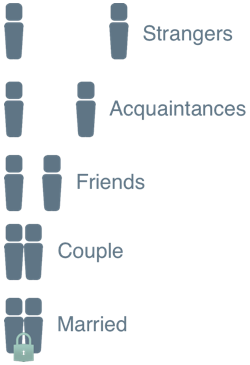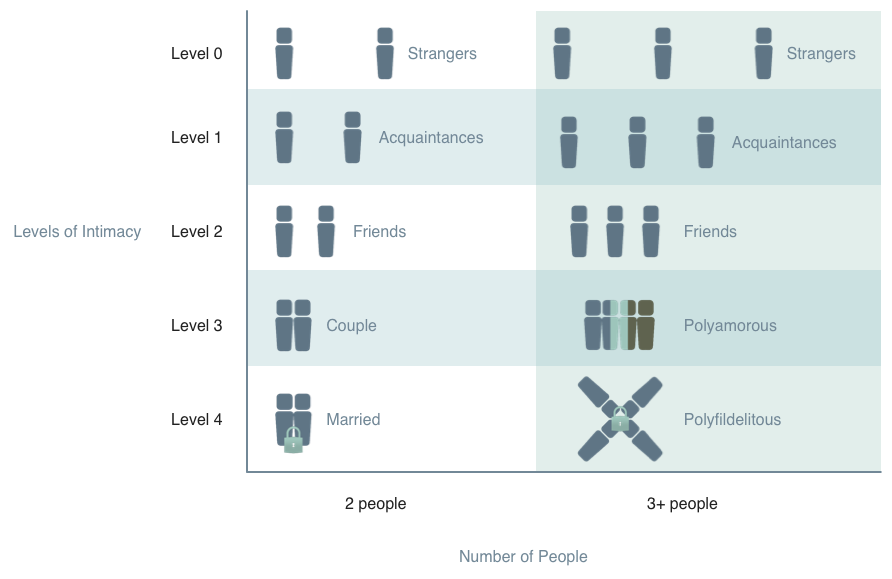Why “Anyship”?
In most societies there is a prescribed hierarchy of relationships allowed to people. Back when a few powerful men in a society had immense control over the lives of nearly all people, these defined relationships helped keep order, but also allowed those men to keep their power.

We’ve inherited a very boring version of these social rules right up to the current day. In many Western countries today, there are really only five main levels of “normal” or acceptable relationships:
- Strangers
- Acquaintances
- Friends & Family
- Couple
- Married
Of course there are several more unstated traditional rules from the same history: familes are heterosexual, monogamous (at least publicly), male-dominated, and outsiders are to be feared and segregated. We also really only recently separated “Couple” from “Married”—it used to be considered deviant behavior to be closer than friends with someone before marriage.
Other modern countries and societies have similar rules; nearly all of them are very structured and usually unquestioned. Because they’re so old, and because most people live with them without causing a fuss, people are weighed down by what’s normal, rarely thinking about why the rules exist or what life might be like if they weren’t followed.
Questioning the Rules
Now that a decent amount of liberty has had a chance to reach many people in modern societies, some of them are starting to ask questions:
- Do I really have to get married?
- Why should it matter if I fall in love with an outsider?
- What if I’m attracted to people of the same gender?
- Can I date multiple people at once?
On this path of opening up our minds, we’ve found that there are often no good reasons for the old rules to remain. In fact, we have realized that many of those old rules were violating individuals’ rights to live their lives in a way compatible with their nature and their choices.
These ideas of individual rights and liberty-to-choose are new, though, and we are still opening our minds to what might happen if we remove the old rules. One of the more recent stopovers on this path has been consensual non-monogamy: the idea that people can choose to have loving or sexual relationships with more than one person at a time, openly, and non-casually, as a lifestyle.
Pushing Relationship Boundaries
Consensual non-monogamy (or polyamory) has been an especially important stopover because, unlike the progress made in the past, we are no longer just teasing apart one layer of the old hierarchy (e.g. separating Couple from Married), or expanding the hierarchy to a slightly bigger group of people (e.g. allowing people to marry interracially). This time we’re threatening to upturn the whole idea of a straight line of relationship steps separated strictly by levels of intimacy and always involving two people at a time.
Now we might have relationship connections involving three people, or even five! Whether all in relationships with one another, or simply linked one-to-the-next through certain individuals, we’re going horizontal and off the map: there’s no rule book for this.

But even polyamory is largely just expanding on the old levels of “Couple” or “Married”—giving people a way to become intimate on those levels with more than one other person. Those people will still even refer to one another using familiar terms from the old structure: spouse, lover, boyfriend, girlfriend.
What if, in addition to breaking some of the old levels by pushing out sideways to add more people to a given intimacy level, we also got rid of the idea of levels as strict boundaries, and defined relationships in any direction and at any point of intimacy on the spectrum?
This is Why
So instead of being forced to pick a predefined level with specific rules for every friendship, relationship or person you know in your life, what if you could talk to that person, figure out how you want to communicate and behave toward one another, and then simply be that way?
Instead of letting social rules define what “friends” should do, why not talk about it and come to your own conclusions, changing your behavior over time to best suit one another? Once you realize that you can customize your relations with other people in any way on which you can agree, the possibilities are endless and freeing.
No longer do you have to qualify as a couple in others’ eyes before you can kiss someone, nor need you be good friends (or on the way to being good friends) before hanging out together at the beach. You can simply talk, agree, and live happily.